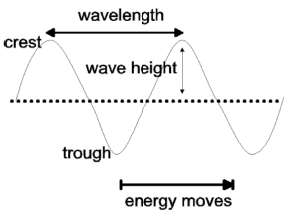BACKGROUND:
 The
energy released by earthquakes travels through the Earth as seismic waves.
These waves pass through different substances at different speeds and
frequencies. Seismic waves can be recorded and measured on a seismograph.
The record produced by a seismograph is called a seismogram. The
interpretation of the waves provides seismologists with a way of
"seeing" into the inside of the Earth. Since we cannot drill very
deep into the Earth’s crust, the evidence from seismic waves is very
important in interpreting the Earth's internal structure.
The
energy released by earthquakes travels through the Earth as seismic waves.
These waves pass through different substances at different speeds and
frequencies. Seismic waves can be recorded and measured on a seismograph.
The record produced by a seismograph is called a seismogram. The
interpretation of the waves provides seismologists with a way of
"seeing" into the inside of the Earth. Since we cannot drill very
deep into the Earth’s crust, the evidence from seismic waves is very
important in interpreting the Earth's internal structure.
Waves transmit energy between different points. Seismic waves are a type
of physical or vibrational wave. Waves have several parts, as shown in the
figure 1. In the picture, the dotted line represents the undisturbed
surface, and the wave is moving left to right. The crest is the high point
of a wave. The trough is the low point. The wavelength is the distance
between adjacent crests (or troughs). The wave height is the vertical
distance from the undisturbed surface to the wave crest. In general, the
bigger the waves, the more energy they carry. Larger waves will be steeper
than smaller, less energetic waves of the same wavelength. If the wavelength
stays the same, but the energy increases, wave height increases as well.
As they go through different substances, seismic waves will change speed
and sometimes change direction. In lab, students will look at some of these
changes. During an earthquake wave motion can cause serious damage. For
example, an earthquake may cause little damage at its epicenter if that area
is on stable bedrock, even though it is the closest point to the focus.
However, as the waves travel further away through the Earth, they may
encounter unstable rock or soil. This area may respond by
"sinking," due to liquefaction. Liquefaction takes place when
ground shaking makes sandy or wet soil to become "liquid". The
water flows out of the ground, allowing it to compact. Liquefaction will
cause buildings to become unstable and possibly collapse. Although far away,
damage in such an area may be greater than at the epicenter.
The Pre Lab helps students to visualize wave movement. In the Lab,
students will be asked to visualize how energy is transmitted through
different substances.
PROCEDURE:
- Review the words on the vocabulary list with the class. It is
important that they understand these terms, which they will use in Lab.
Draw the wave diagram shown in the Background section on the board.
- Draw the following seismograms on the board, or use the presentation
images. Ask students the following questions:

- Which seismogram has the shortest frequency? A
- Which seismogram represents the most energy? C
- Which seismogram has the largest wavelength? D
- Which seismogram has the shortest wavelength? A
- Which seismogram shows different sizes of waves? B